#the restaurant made sure to make it extra soupy..
Explore tagged Tumblr posts
Text


240624 bubble update
#hyunjin#skz#stray kids#🧼#THE SOUP DUMPLING I ORDERED JUST ARRIVED.#the restaurant made sure to make it extra soupy..
239 notes
·
View notes
Text
First Date: Part 1/??
I'm very proud of this, for this being my first snzfic on tumblr.
Summary: James is going out with a doctor, Doctor Matthew J. Edward. However, he gets sick, but he doesn't want to cancel on the guy. Plus, he's experienced in this thing.
Pairing: mlm
Content: illness, mess, mention of contagion, sneezing (obviously), coughing
DO NOT REBLOG TO NON-KINK BLOGS
James, the catboy with cat ears, cat eyes, cat fur, and a cat tail, and the one who'd been classified as a freak in his youth, was on his way to the restaurant he was supposed to go to so he could meet up with his date. He'd gotten lonely, so he'd downloaded a dating app. He'd been matched up with a doctor.
Ironic, since he'd started sniffling and sneezing the very day they were supposed to meet up. Here he was now, being forced to rub his nose raw to avoid being that annoying person that sniffles every time they breathe. He just hoped his date, Matthew, wouldn't notice. Though, since he was a doctor, he probably would.
He gave one last soupy sniffle before heading into the restuarant he'd be eating at. He looked around, scanning the area for his date. He noticed someone waving at him, and yep, that was him.
He sat down at the other end of his table and smiled, hoping and praying he didn't notice the red that sat on his cheeks, his chapped nose, or the sweat that formed on his temple.
Thankfully, the lighting was somehow able to hide all of that.
"So, James, you know I'm a doctor. What do you do for a living?" The conversation picked up immediately.
"I, uh, I do a lot of art." He gave a sheepish smile. "I sell it for a lot of money, but I'm not sure I'm actually that talented."
"Oh, I'm sure you're great at it!" Matthew smiled at him, and it made his hear flutter a little.
The conversation continued. It was as if they were old friends.
James was able to stave off the tickle that had been plaguing his poor nose all day, and just as he thought he could make it without having a sneezing fit, this lady came in and sat nearby with perfume strong enough that James could smell it through his cold.
"...Earlier I had a patient come in complaining about chest pains. Turns out, it was only because he spent all night last night drinking beer and eating pizza like it was the fourth of July."
He tried to rub the tickle away. It wasn't working. "The th—hh... th-things people come in for these d—HIH!... days..."
Matthew furrowed his brow. "You all right?"
"Y–hih–yeah, I just... Sorryi'mgonnasneeze—" He sped up before he let out a rapid, "Hishh! TsshhIIUU! Tsshhi!" into his elbow.
Matthew's expression, to James' relief, softened. "Bless you! That was cute."
His cheeks somehow became more flushed as he rubbed his already raw nose. "Wh–what?"
"Your sneezing. It was cute. Like a kitten. But, uh, I suppose that makes sense."
Before he could respond, his breath caught with another – "Hzzschhh! Nngh... Sorry..."
Matthew's head tilted a bit to the side and he hummed softly in thought. The way he looked at James with concern made him tense up. "Is... Is something in here bothering you?"
"...Y–yeah, actually, I think so. There's a, um... p–perfume— Hnxxtch!" He brought his hand up to catch the next string of sneezes that his instinctive stifle had coaxed out. "S–sorry, force of hh... habit—! HISHIEW!! HISHIUU!! HIH!... HETCHII!!" And along with the string of sneezes, a string of snot came out with them.
He quickly grabbed a handful of napkins as a substitute as tissues and wiped the mess away. "S–sorry—!" He felt the eyes of everyone else in the restaurant staring at him as he grabbed more napkins. Anyone could tell he was uncomfortable with it too.
Matthew grabbed a handful of extra napkins and helped him out of his seat. "It's okay, you're fine. Let's get you some fresh air, yeah?"
"Sdf... Hh'EKSHIEW!!" was the only thing Matthew got in response from James. That, and a cough.
"Bless you." Matthew gently rubbed his back as he held him close, leading him out of the restaurant, away from the disgusted glares of strangers.
James only felt comfortable to properly blow his nose when they were alone outside, and that he did. It did absolutely nothing to relieve the congestion, but it seemed to nullify the tickle a little, as his sneezing soon came to a pause.
The bad news was the lighting made it a lot easier to get a better look at him outside. "James..."
"Hm'b?" Matthew brought a hand to his forehead to check for a fever. James leaned into his warm touch.
"...Mhm... You're burning up." He gazed at the other softly.
"Whad't are you talkid'ng aboud't? Im'b freezid'ng..." He hugged himself and shivered a little, avoiding eye contact.
"...Chills, too..." He thought for a while before deciding. "Do you have all of your stuff?"
"What'd?" His ears perked up, just barely.
"Don't feel bad, but I'm taking you to my house and I'll take care of you there. I'd take you to your house, but I want you to be able to rest in the car."
He just nodded slowly, letting Matthew lead him to his car.
#snzfic#I just love the idea of a doctor dealing with a sick partner on a first date#I died writing this#hope you like it#snzario#sneeze#sneeze kink#snz things#snz
20 notes
·
View notes
Text
Unpinned - French Onion Chicken
Welcome back, my lovelies! Since we last met the entire world has turned upside-down. Everything has changed! Holding hands is from the BEFORETIME. Being in other people’s houses is from the BEFORETIME. Restaurants are from the BEFORETIME. I could go on and on about the darkest timeline we find ourselves in, but after losing all sense of self and purpose in this nightmare reality, one thing has become clear: we still gotta eat. On a recent Zoom call with dear friends (the bizarre irony of how we’d never met face to face until a pandemic was not lost on me) I was reminded of this blog. Bless their hearts, they had kind words to say about my ramblings. So I thought WHAT THE HECK, IT’S NOT LIKE I DON’T HAVE THE TIME! (Ha, time and any semblance of meaning are *also* from the BEFORETIME) so here we are. I cooked a thing and now I’ll tell you about it.

French Onion Chicken! From the folks who make those cute facebook cooking videos, Delish! I guess they have a magazine too. I get a little suspicious of any publication that claims the majority of their recipes are ‘TEH BEST EVAR’, but after this dish I could be convinced.
Verdict: Is the Pintrest photo complete bullshit? - I’ll let you be the judge when you see the photo of my finished product, but I’m going to quietly sit over in the corner nodding furiously in the meantime.
Is it crazy expensive/time consuming/confusing? - The only pricey ingredient was a block of gruyere, and it was worth every single penny! It took about 45/50 minutes from start to finish but time is a cruel joke anyway so who cares? It was pretty straightforward and easy!
Does it taste good? - YES. MAKE IT.
French Onion Chicken
Ingredients
3 tbsp. extra-virgin olive oil, divided
1 large onion, halved and thinly sliced
2 tsp. freshly chopped thyme
Kosher salt
Freshly ground black pepper
2 cloves garlic, minced
1 3/4 lb. boneless skinless chicken breasts, cut into 1" pieces
1/2 tsp. dried oregano
2 tbsp. all-purpose flour
1 1/2 c. low-sodium beef broth
1 c.shredded Gruyère
Freshly chopped parsley, for garnish (optional)
Preparation
In a large skillet over medium heat, heat 2 tablespoons oil. Add onions and season with salt, pepper, and thyme. Reduce heat to medium-low and cook, stirring occasionally until onions are caramelized and jammy, about 25 minutes. Stir in garlic and cook until fragrant, 1 minute more. Turn off heat and remove onion mixture. Wipe skillet clean.
In a large bowl, season chicken with salt, pepper and oregano, then toss with flour. Heat remaining oil in same skillet over medium-high heat. Add chicken and cook until golden on all sides and mostly cooked through, about 8 minutes.
Add beef broth and return caramelized onions to skillet. Bring mixture to a boil, then reduce heat and simmer until chicken is cooked through and beef broth reduces slightly, about 10 more minutes.
Add Gruyère and cover skillet with a lid. Cook until cheese is melty, about 2 minutes. Remove from heat and garnish with parsley before serving.
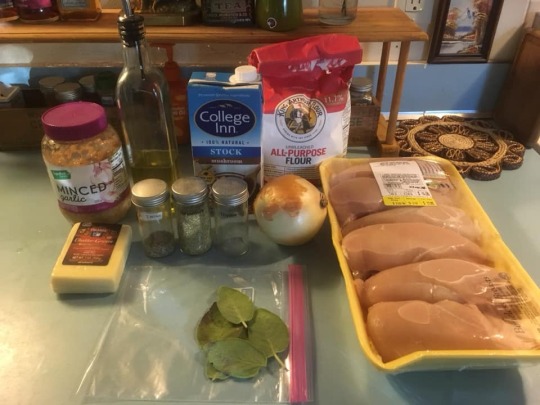
Here’s what you need! You’ll notice a small pile of leaves at the front and may wonder why I’ve thrown foliage onto my counter. Long story short: Allan’s lovely Aunt Kathi and Uncle Eli gave us bags of fresh herbs from their garden, and we’ve been making such fancy herby dishes! These are the last fresh sage leaves; I know the recipe calls for thyme but we’ve got sage so now the recipe calls for sage.

First thing’s first: oil up your trusty cast iron. You’ll notice that it looks like I’ve smeared dark gritty mud along the bottom of mine, and that is because I am a lazy no-good cast iron owner who does not properly season her pan. It’s frankly a disgrace. I will pay someone to fix it for me.

Slice yer onions! Somehow this giant beast didn’t even make me tear up!
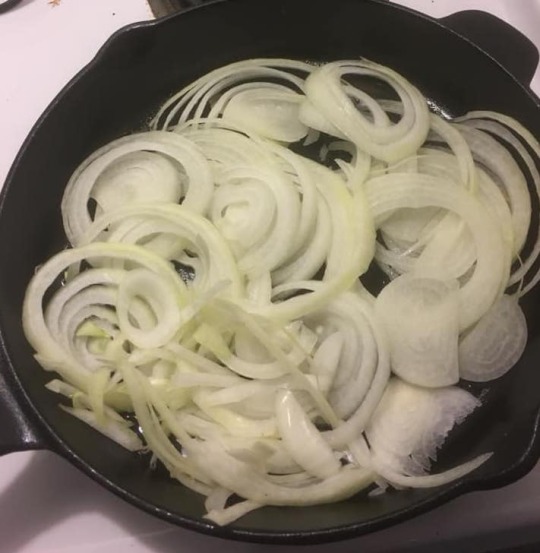
At this point the meal could be done and I’d be pretty happy - who doesn’t love a pan of hot onions? They started to smell tasty, which was great ‘cause our apartment has lately had a weird smell of old meat, which is EXTRA concerning because we haven’t cooked any meat at all this week. Why does it smell like meat.
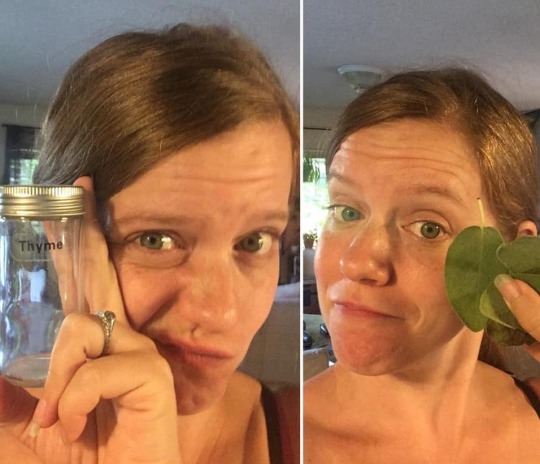
IT APPEARS WE’RE OUT OF THYME. AHAHAHA AREN’T WE ALL? Sorry guys, I’m realizing now that this cooking experiment was also a litmus test of my current five-months-into-lockdown mental state. Clearly I’m fine. Also we had sage so it was all good.
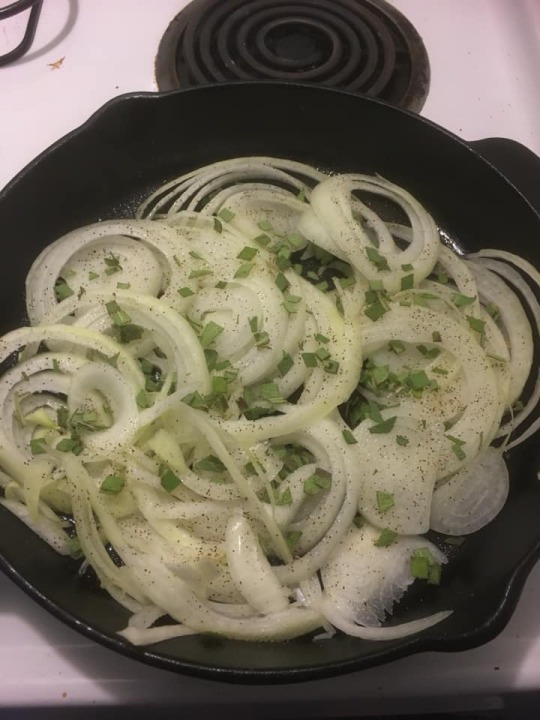
Sage-y onions. The kitchen was smelling very, very good.

I really had to trust the recipe on this one and let the onions cook for the full 20+ minute time even though I was oddly anxious they would burn. I ended up turning the heat down to low when I started to see a lot of crisping. To distract myself, I started chopping the chicken breast into cubes. They were meant to be about 1″ x 1″ x 1″ but most of them came out more like .5″ x 6″ x 2.89″.
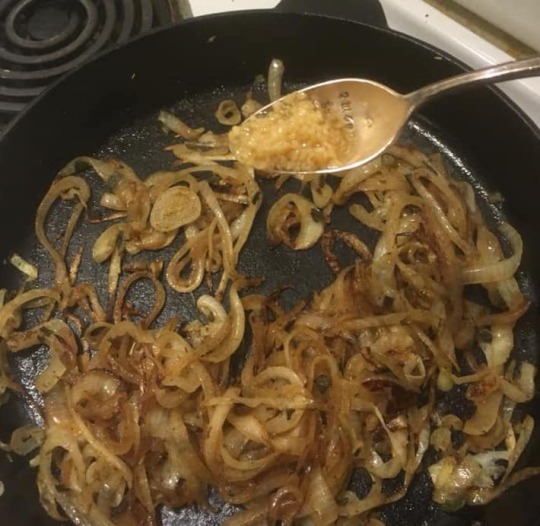
My patience paid off! The onions, looking quite “jammy” and caramelized! I kept wondering what “jammy” would look like but I think it’s just a fancy way of saying “sticky and mushy”. Adding my scoop of jar-garlic because even in lockdown I don’t have time to mince fresh garlic.
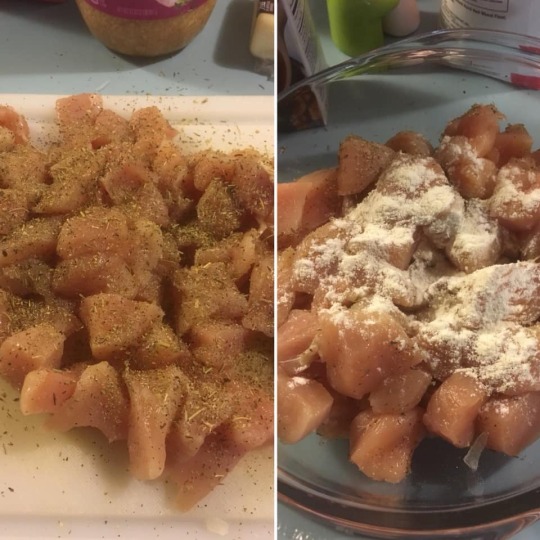
This bit was a little tricky: it called for two tablespoons of flour to “coat” the chicken but I wasn’t sure how such a tiny amount of flour was going to “coat” jack squat. So here’s the heavily-seasoned chicken on the cutting board, and my tentative first attempt at adding flour.

It just sort of made the pile of raw chicken into a slightly more-beige, stickier pile of raw chicken. I was unconvinced.

Ok I got them in the pan to start cooking and it looks vaguely like normal chicken? Now my instinct is to cook the shit out of chicken until it’s just little shreds of carbon to avoid salmonella, but I see that the recipe says that to let it finish cooking once we add/boil the liquid, so against my better judgement I just cooked them “medium rare” and moved on.

It called for a cup of shredded cheese but I just shredded the whole block because honestly when in history has a dish ever been ruined by too much cheese? (Spoiler: never)
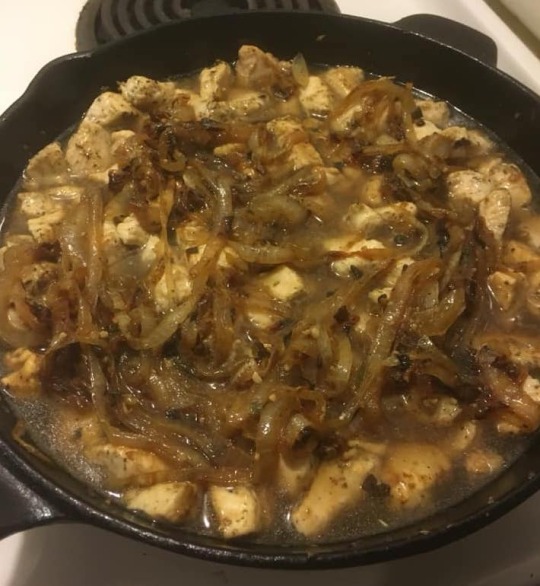
Oh wow! It looked so good when I added the stock and onions back in! We used mushroom stock ‘cause we’re trying to minimize our beef consumption and also mushrooms are delicious.

BUT THEN IT TURNED INTO THIS WATERY MESS WHEN I ADDED AND STEAMED THE CHEESE!

This is not staged, this is 100% exactly the face I was making as I saw what my end result was looking like. It was definitely straight-up soup, and no thickening instructions in sight.
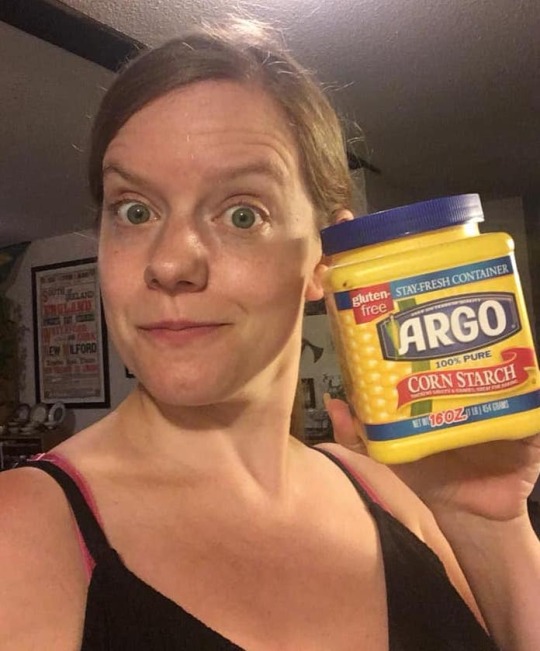
So I harkened back to my years of training as Thanksgiving sous-chef with my grandma! Whip out your trusty cornstarch and turn that soupy frown upside down!

Take out your commemorative New Milford mug (whoot whoot hometown pride oh god I miss traveling across state borders) and make a cornstarch slurry. Starts as cement-like glue-chunks, add drops of water and keep scraping until it becomes an opaque liquid.

So here’s how it looked immediately after adding the ~1.5 tbsp cornstarch slurry and then after a good stir and extra minute on the heat. No more soup!
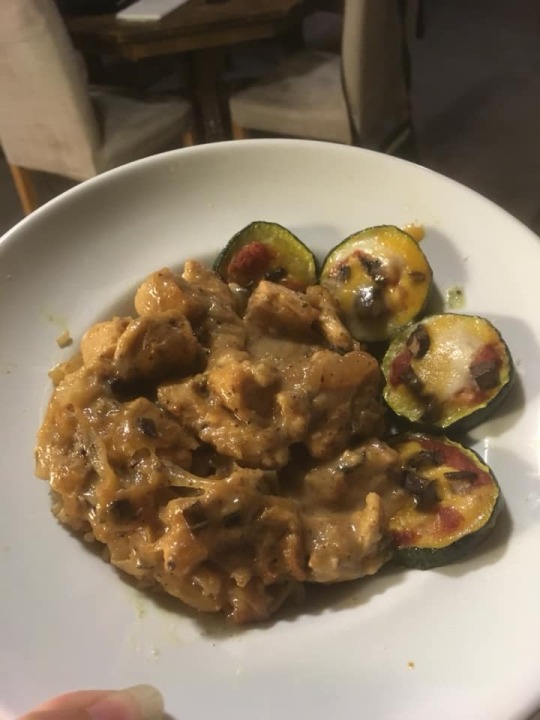
And finally plated: atop some brown rice (cooked with homemade chicken stock) and little zucchini pizza bites (made from one of the monster zucchini from my garden).
Final final verdict: It really did NOT look like the Pintrest photo, but to be fair I did skip the (apparently essential) step of adding fresh parsley - between you and me I’m pretty sure they hit it with a blow torch to get that nice crispy top. BUT! This was actually DELICIOUS. Like, really really good. The chicken was moist, the cheese flavor was sublime, the onions were jammy to the extreme: I’m definitely going to make this again!
2 notes
·
View notes
Text
Muslim Bean Soup
This Recipe for White Bean soup also known as Navy Beans (for being served in rations to US Navy sailors in the late 19th century) is a family staple that has been being passed down for generations. Slow cooked beans that will just melt in your mouth, flavored by smoked turkey or ham hocks, traditionally accompanied by buttery cornbread and stewed collard greens. My mother grew up eating bowls of White Bean Soup, or Muslim Beans as they will refer to it, in a small one-story house with her 6 siblings in Louisville.
Like my Southern Lentil Stew, this is a recipe involving legumes (beans), so the recommended method of cooking will involve SOAKING your legumes at least 8 hrs before cooking (This is for your own good). In one vegan restaurant I worked at, we were so behind on the daily schedule that we cooked the beans without pre-soaking them. The effect that this had on the finished beans was not visible to the eye. But after a full bowl, or even a cup, your digestive system will let you know what you did wrong. They called it the Miles Davis effect.You don’t need a trumpet to make musical sounds, the beans will help you toot your own horn! You don’t want to make that same mistake we made and serve unsoaked beans to loved ones, especially not when you’re all quarantined in the same house. An easy alternative would be to buy and use canned beans. If you choose to do that, more power to you! I’m definitely not judging you by the way.
Take your time with these beans! Greatness takes patience and I guarantee you won’t be upset with your results!
Prep time: 8 hours (only if using dry beans)
Cook time: Close to 2 hours
Yield: 10-12 servings
INGREDIENTS:
2 cups dried White Beans (Navy Beans)
4 stocks Celery
1 Large carrot
1 Onion
1 Bell Pepper
1 Jalapeno (more if you like it spicy)
4-5 cloves Garlic
1 Smoked Turkey Leg
Salt & Pepper
2 Tsp Smoked Paprika
1 tbsp Knorr or 2-3 Bouillon Cubes
DIRECTIONS:
Add soaked beans into a large pot with about twice as much water as there are beans. If you started with 2 cups of dried beans, which is 4 cups after soaking (they double in size), I’d say use about 8 cups of water to boil. Bring to a boil and then simmer over a medium heat with the top slightly ajar for about 45min - 1hr or until tender to the spoon-press-test. As they cook, the majority of the water will evaporate from the pot so make sure there is an ample amount of water. If you’re using canned beans, you don’t need to add as much water. Fill the empty can up with water twice and that should be enough to start cooking.
In a separate Pot, boil your Smoked Turkey Leg. Once the meat is tender, remove from the pot and shred with a fork. SAVE the WATER! This can be used to add to the beans if the water is evaporating fast, or if you just want the extra flavor!
In a frying pan, sweat the celery, onion, carrot, bell pepper, jalapeno and garlic. Use salt and try to caramelize these. Cook until onions are golden brown for maximum flavor.
When the beans are tender, add your seasonings and Knorr or bouillon, or whatever stock seasoning you have and simmer for 5 more minutes. Check your water level, do you want these beans to be more soupy? Add a little more water. Do you want them to have a more creamy thick consistency? Let the beans cook down a little more.
Finally, after your beans have reached your desired consistency, add in your sauteed vegetables, and turkey meat. Taste for salt, and you’re finished.
Try this Recipe out! Send me pictures and let me know how it turns out! I’d love to see it. If this recipe spoke to you because you also grew eating White Bean Soup, then share with somebody you love! If there is anything you’d like to see a recipe for DM me and I’ll write about it! I’ve got some more slow cooking meals (Oxtails!) coming soon!
#good art#good people#art#food#food photography#self help#self love#read#long reads#good reads#meaning#purpose#story#story time#good food#healthy food#journal#journal entry#journey#cuisine#beans#home cooking#stay home#quarantine#friends#family#friends and family#friends and lovers#love#stayhome
2 notes
·
View notes
Text
XCOM: Chimera Squad review – a generous and inventive spin on a tactical classic • Eurogamer.net
Breaching a room is one of those weird things that games turn out to be brilliant at. It’s pure tactics – information with stimulating gaps in it. A bunch of bad guys are waiting behind closed doors. You know some things about them but you don’t know everything. How are you going to open the doors?
XCOM: Chimera Squad review
Developer: Firaxis Games
Publisher: 2K Games
Platform: Reviewed on PC
Availability: Out now on PC
It’s a wonder, really, that it’s taken a classic tactics series like XCOM so long to try a bit of breaching. XCOM 2 encouraged you to think of ambushes, sure, but with XCOM: Chimera Squad, the latest instalment in the series and a standalone adventure with a somewhat focused scope, breaching finally has its moment.
And it’s glorious. Chimera’s missions play out room by room, essentially – or encounter by encounter really as most of the game’s spaces are multi-room environments – and with none of the prolonged knocking around looking for a fight that previous XCOM games used to feature. Each encounter starts with a breach. You choose your door, you choose who opens it and who goes in next, you plan, you fiddle around, you change your plan and switch everyone out again and have a comforting Pop-Tart – just me? – and then you commit.
Pure tactics, information with gaps in it: every door tells you how high the likelihood is that you’ll take damage. Every door generally offers its own twists too. Maybe your shots will stun if you use this door. Maybe they’ll crit. Maybe the first one through can’t miss. Maybe the last one through won’t be able to move afterwards. Maybe everyone gets free Overwatch. Generally you have a choice of doors and windows to spread your four-person team across, and you can buy items as the game progresses that allows access to new doors – security doors and vents, say. I love this breach moment – it’s new, but it already feels like pure XCOM. You’ve thought about the odds, the perks. You’ve lined up your guys. Pop-Tart. BREACH.
Once you’re through time gets wonderfully thick and soupy. It reminds me a little of the stand-offs in John Woo’s Stranglehold, may it rest in glorious peace. Everyone gets a chance to breach fire – which means you each get a free shot as you scramble through the doors. If you’re playing on easy where the dice are loaded in your favour, four people coming through a door can often clear out four baddies. But even if you’re not, once the breach fire period is over your team scramble to cover and then it’s classic XCOM. Turns, cover, dice rolls, disaster.
Except it’s not, because everywhere throughout Chimera Squad there are playful tweaks and rebalances. Firaxis always strike me as the molecular gastronomists of the strategy and tactics world, a wide, dappled genre that in itself is sort of the molecular gastronomy of video games. Anyway: Firaxis can’t stop fiddling with things. Instead of foams and crumbs and airs, though, these designers like to dig down into the basics of a game and ask fundamental questions. Chimera Squad asks: hey, how about breaching? And then it asks: how about smaller maps, which play out as stacked encounters, so there’s no fat, as it were, no connective tissue to worry about.
But it hasn’t stopped tweaking there. In classic XCOM you move your guys and then the aliens move their guys. Chimera Squad opts for interleaved moves. Wonderful word, interleaved. Precise and papercrafty – one for the specialists, the scholars, the obsessives. Interleaved moves means one of your guys makes a move, and maybe one of theirs goes next? It makes fights much more dynamic, and more personal. You have more power, but with XCOM that always means the power to screw up. Classic XCOM meant that a situation you hadn’t foreseen could pop up and be resolved – usually tragically – in the course of an alien turn with little for you to do but stand around and take it. Classic XCOM was somewhat concerned with the delicious pain of tactical paralysis.
By contrast, Chimera Squad means you can see a situation develop and then you have the chance to do something, because you might get a turn in between two alien turns. But with that power comes the fact that this is still XCOM: clear shots can miss, aliens can be extra sneaky, things can go wrong in enormously creative ways. Interleaved moves bring great invention and dynamism and even wit to the game. And of course, it’s all information with gaps in it: the turn ticker is clearly visible on one side of the screen, and there are unit powers that allow you to sacrifice a shot, say, for the chance to change the order of turns to your advantage, to shuffle one of your cards in before one of theirs and save the day. Or try to save it, anyway. But what will the response be?
How deep does the tinkering with the basics go? It’s wrong with Chimera Squad even to talk of your turns and alien turns. This latest game plays out after the events of XCOM 2, in a city where humanity and aliens are trying to get along together. How are things going? Well, in the opening cut-scene the mayor is blown up in a truck. So they’re not going very well. I think Firaxis is aiming for something a bit like The Third Man’s Berlin, parcelled up amongst uneasy “allies”. It’s a lovely setting for an XCOM game. Previously they’ve concerned themselves with invasions. This one’s more about insurrection – insurrection played out in three acts, and three factions’ investigations.
And all of this means that your squad is formed of human and alien team-members. The focus on Chimera Squad is much more personal than most XCOM games. Your team have cut-scenes and names and personalities and dialogue and banter and everything. It’s XCOM: the Saturday Morning Cartoon, even before you get to the stylised storytelling sequences that use lurid four-colour layouts and halftones that can’t help but remind me – oh glory! – of the beautifully ugly excesses of Codename STEAM.
Does it feel weird that you can’t name your own soldiers anymore? In truth, I didn’t miss it that much. After a few hours I’d forgotten that I ever used to go into battle with units named after my favourite takeaway restaurants. I started to feel close to my new guys, from the awkward muton who sometimes sounds like Jeff Bridges to the techy who always misses – for me at least – but has a drone that shocks anyone who gets too close, a kind of electrical wasp at the XCOM picnic. Keeping units alive for the whole game means that XCOM’s power snowball thing is in full effect: you can get to a point where everyone’s so riddled with interesting skills that you start to feel bad for the guys you’re up against. But I was still learning to get the best out of people by the end of the surprisingly involved campaign. One of my guys had psionic powers and could change places with any unit on the battlefield. This meant if a mission-critical baddy was making a break for the exit I could swap places and move them into the heart of my ranks. But it also meant I could zap high cost baddies over to exploding barrels and then touch them off. The fun never ends.
Ah the campaign. Given the low price for a standalone game I was expecting Chimera Squad to clock in at about three or four hours. In truth, it kept me busy for two days on my first playthrough. What’s happened, I think, is a narrowing of focus: shorter missions, smaller teams, a simpler strategy layer and throughline.
I think the new strategy layer is fantastic. I love settling in for a game of XCOM 2, knowing that I’ll be dozens of hours deep before I realise I made a crucial mistake at the two hour mark, but it can be quite an elbowy and confusing game, with layouts, maps, and perhaps not quite the clearest sense of all the things you should be focusing on, at least for your first chaotic attempt. Chimera Squad is much more straightforward. Base building’s out and the whole thing is set in a single city as you chase down a single mystery, one suspect faction at a time. Alongside missions that advance the story, you also have missions that earn you resources and also allow time to pass until the next story mission becomes available. While all this is going on you have to monitor the whole city, making sure tension never gets too high in each of the districts. Completing missions in a district will bring the tension down, but you can also buy agencies that sit in each district and have limited powers to calm things down in interesting ways, or at least freeze the escalation for a few turns. All of this is presented via a 3D map that is colour-coded so you can instantly see how things are going. If most districts are blue, then happy days, as Tuffers would say. I wouldn’t mind getting Tuffers in an XCOM team.) If they start to turn towards red you’re going to have to do something.
There is a term for this kind of thing – I want to call it the small blanket problem or something like that? Anyway, in classic XCOM style, you never have enough time and resources and people to maintain total calm in the city. You’re always making trade-offs. And when it comes to your people the trade-offs never stop. You need four team-members to go out on missions, but you also want to staff the streamlined lab that makes breakthroughs and allows for new gadgets. You want to send people away on Spec-Ops that earn you resources or may lower tension in the city. If people are wounded – or if you just want to improve their stats – you’ll want to send them for training. All of this means you’re juggling who you can actually take out shooting, trying to make sure everybody gets leveled up nicely and gets new abilities, while also ensuring that nobody’s battle damage results in untreated “scars” that affect their stats.
It’s a lot to think about – of course it is, it’s XCOM. But Chimera Squad is a lot more approachable than XCOM 2. It’s more direct, less expansive, sure, but also a little less muddlesome to stupid people like me. This isn’t XCOM 3, but it isn’t pretending to be. It’s something different – a characterful, sharp-edged, surprisingly rich side-quest. It will keep me busy for hours and hours, I think. That’s the thing about doors – I always want to know what’s on the other side.
from EnterGamingXP https://entergamingxp.com/2020/04/xcom-chimera-squad-review-a-generous-and-inventive-spin-on-a-tactical-classic-%e2%80%a2-eurogamer-net/?utm_source=rss&utm_medium=rss&utm_campaign=xcom-chimera-squad-review-a-generous-and-inventive-spin-on-a-tactical-classic-%25e2%2580%25a2-eurogamer-net
0 notes
Link
My daughter’s boyfriend recently came back from Singapore and declared his favourite dish is now laksa. I have a lot of empathy with him as laksa is also a strong favourite of mine and it made me realise that I have not had a laksa for years, living in France.
So it was something of a surprise and relief to hear that laksa restaurants are now sprouting around London, a city which I visit several times a year and where I am currently writing this.
To research the dish, my daughter and I planned visits to several restaurants serving laksa but in the end, we only managed two venues due to work and other issues.
In preparation, I did some investigation into what constitutes a laksa. And there is no straight answer due to the varieties of laksa available. One would have thought all laksa would have something in common, but that is simply not the case (with the exception of bean sprouts).
Varieties
As I grew up in Johor, the first laksa I had encountered was Johor Laksa, an idiosyncratic version seldom found anywhere else. It comprises thick noodles, sardine paste tangy with calamansi limes, cooked in coconut curry gravy with laksa leaves and garnished with fresh salad.
Later I discovered a different laksa in Kuala Lumpur, which actually originated from Ipoh. This is a bowl of rice or wheat noodles drenched in a spicy orange/gold soupy gravy prepared with pulverised dried shrimps, curry paste, sambal (shrimp-based chilli paste), garnished with fish cake slices, fried tofu cuts and/or chicken.
Bloody raw-looking cockles are often an extra addition for just a few cents more. This is more commonly known as curry laksa.
Assam laksa is popular in Penang. Photo: Filepic
And in Penang, there is the fragrant but punchy assam laksa, a rice noodle bowl which uses no coconut milk in a broth based on tamarind, lemongrass, belacan (fermented shrimp paste), fish bones and garnished with ginger flower, bean sprouts, cucumber, shaved onions, raw chillies, mint, prawn paste, chopped fish and laksa leaves.
The Singapore laksa seems to be a sanitised variant of curry laksa from Kuala Lumpur or Ipoh, though it does not offer the option of bloody cockles and may introduce char siew (barbecued pork) or roast pork instead.
Laksa leaf
One would have thought that all laksa would necessarily contain the eponymous laksa leaves. But this is not the case as curry laksa typically do not use them. Nevertheless, the leaf itself is an interesting subject.There are actually two kinds of laksa leaf, which taste similar and are used interchangeably. One is known scientifically as Persicaria odorata and the other is Polygonum minus or Polygonum minor.
The first species is commonly known as Vietnamese coriander in the West, daun laksa (Malaysia), Rau Ram (Vietnam) and Phak Phai (Thailand) where it is the main spice in various kinds of tom yam dishes.
The second species is known as daum kesum and is popular in Malay dishes. Both species are related to knotweed and are from the Polygonaceae family; they are both perennial creepers native to South-East Asia.
The daun kesom is a type of laksa leaf. Photo: Filepic
Both species have high concentrations of aliphatic aldehydes in its oils which contribute to their particular aroma and flavours; eg. decanal and dodecanal.
In total, 69 aroma compounds have been identified in the plant oils by chromatography and mass spectroscopy. These compounds are also claimed to have antimicrobial, antioxidant, immuno-stimulant and anti-carcinogenic properties. Additionally, laksa leaves have a relatively wide spectrum of mineral/vitamin nutrients and the high oxalic acid content is also a digestion aid.
In other countries, Persicaria hydropiper, also known as the water-or marsh-pepper, is sometimes confused for the laksa leaf plant. Wild water-pepper contains compounds which can irritate the skin so the Japanese use cultivars (specially cultivated varieties) of water-pepper to make a garnish for sashimi and also an unusual water-pepper sauce served with grilled fish.
History of laksa
Laksa is acknowledged to be a Peranakan concoction, based on the historical co-mingling of Chinese, Malay and Indonesian influences, with probably a touch of Indian as well.
The origin of the word laksa itself is particularly hazy. One leading theory is that it came from the Persian word, “lakhsha” which translates roughly into “slippery”, and possibly alludes to the noodles in the bowl, according to the Oxford Companion to Food.
Or it may have been a bastardisation of the Cantonese words “ley sah” (or “spicy sand”) which references the texture of the ground dried prawns used in some versions. Or it might have come from the Sanskrit “laksha” which is the word for “many” and may be a reflection of the many ingredients in the dish. The least attractive suggested origin may be the corruption of the Hokkien phrase “lup sup” which basically means “messy” or “dirty”.
From the name history, it is feasible that laksa, or at least curry laksa, may have originated before the use of laksa leaves as an ingredient.
Laksa In London – Part 1
As mentioned, I managed to sample only two restaurants serving laksa in London – I am not sure of the exact number of laksa restaurants now but it is certainly far more than when I was last living there over 20 years ago.
My daughter says more than a dozen venues are selling the dish and it is marketed frequently on social media.
Laksa has becoming increasingly popular in the West, with restaurants like Laksamania in London leading the charge. Photo: Chris Chan
It may be laksa is now the current foodie fad in London. It would not be surprising as fads come and go easily (and often) in large metropolitan cities and the surprise is that laksa is doing so well as it would normally be too spicy for Western tastes.
The first place we ambled to was Laksamania, where my daughter had the Ipoh laksa and I ordered the Singapore laksa.
Both were curry laksa and we were curious about the difference. The restaurant is contemporarily pleasant, with lots of elegant dark wood. The laksa duly arrived and both tasted quite good but were missing the undefined “zing” of a real laksa.
Also, one of the laksa (I forget which) also had an unusually strong flavour of star anise which was interesting, but lost it a few marks on the authenticity scale. That is because star anise is not a flavour I normally associate with curry laksa even though it tasted quite pleasant.
Laksa in London – Part 2
I initially had low expectations when we visited the second venue, partly because a senior UK food critic raved about it too fervently. Usually, when a food critic is so biased, it means he likes the food but that does not necessarily apply to everyone else.
I need not have worried as the dining at Singapore Garden is indeed quite good. They only have the Singapore (curry) laksa and it tastes as authentic as what one would expect at a good food court in Kuala Lumpur.
The evening was enhanced by bumping into a waiter we had known for many years and who helped us choose the best dishes on the menu.
Both places were not expensive by London standards and subjectively worthwhile to get over the craving for laksa. I also bought some packs of curry laksa paste to take back to France to try on some adventurous (and unsuspecting) friends.
There is one other curiosity about laksa leaf. In Vietnam, laksa leaves are used to suppress sexual urges, and Buddhist monks grow and eat the leaves to help maintain their celibacy. If you are looking for the opposite effect, then the Vietnamese believe that raw bean sprouts improve libido.
I have not researched these claims though it is interesting that the only ingredient in common with all laksa is bean sprouts.
from Food – Star2.com https://ift.tt/2MTH6Jy
0 notes